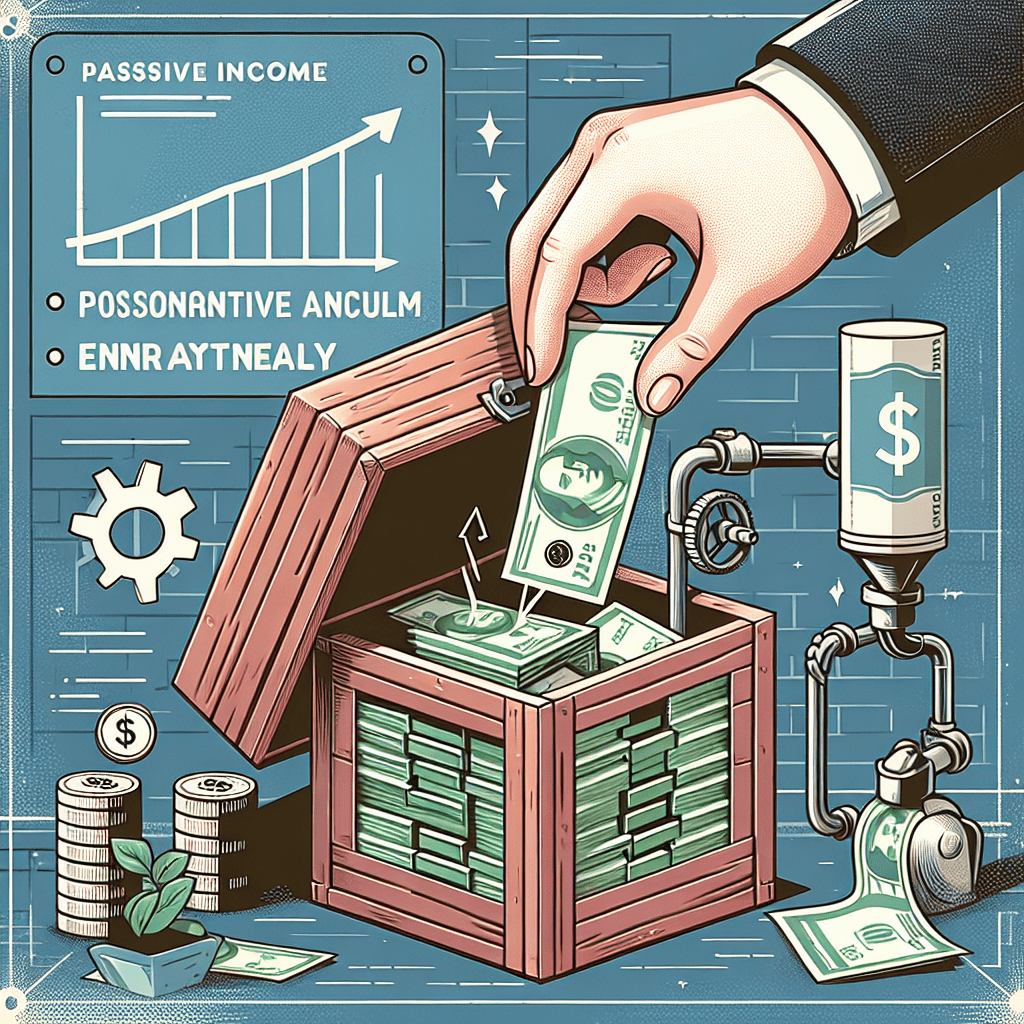“Unlock Steady Growth: Invest $4,500 for Over $100 in Annual Passive Income!”
Introduction
Investing in value stocks can be a strategic way to generate passive income, especially when focusing on affordable options with strong fundamentals. By allocating $4,500 into a carefully selected value stock, investors have the potential to earn over $100 annually in passive income. This approach not only leverages the power of dividends but also capitalizes on the stock’s potential for appreciation. Value stocks, often characterized by their lower price-to-earnings ratios and solid financial health, offer a compelling opportunity for investors seeking steady income streams without the need for significant capital outlay. By choosing a stock with a reliable dividend history and growth prospects, investors can enhance their portfolio’s income potential while maintaining a focus on long-term financial stability.
Understanding Value Stocks: A Beginner’s Guide
Investing in value stocks can be an effective strategy for those looking to build a portfolio that generates steady passive income. Value stocks are shares of companies that appear to be undervalued based on their financial performance and intrinsic worth. These stocks often trade at a lower price relative to their earnings, dividends, or sales, making them attractive to investors seeking long-term growth and income. For beginners, understanding the fundamentals of value investing is crucial to making informed decisions and maximizing returns.
One of the key principles of value investing is identifying stocks that are priced below their intrinsic value. This involves analyzing a company’s financial statements, including its earnings, revenue, and cash flow, to determine its true worth. Investors often look for companies with strong fundamentals, such as a solid balance sheet, consistent earnings growth, and a competitive advantage in their industry. By purchasing these stocks at a discount, investors can potentially benefit from price appreciation as the market recognizes the company’s true value over time.
In addition to capital gains, value stocks can also provide a reliable source of passive income through dividends. Dividends are payments made by a company to its shareholders, typically on a quarterly basis, as a distribution of profits. Companies that consistently pay dividends are often financially stable and have a track record of generating positive cash flow. For investors seeking passive income, selecting value stocks with a history of dividend payments can be a prudent choice.
To illustrate the potential of value stocks in generating passive income, consider investing $4,500 in a well-chosen value stock that offers a dividend yield of approximately 2.5%. A dividend yield is calculated by dividing the annual dividend payment by the stock’s current price. In this scenario, a 2.5% yield would result in an annual dividend income of $112.50, providing a steady stream of passive income without the need for active management.
Moreover, the benefits of investing in value stocks extend beyond dividends. As these stocks are often undervalued, there is potential for significant capital appreciation as the market corrects its valuation. This dual advantage of income and growth makes value stocks an appealing option for investors with a long-term perspective. However, it is important to note that investing in value stocks requires patience and a willingness to endure market fluctuations. The market may take time to recognize the true value of a company, and stock prices can be volatile in the short term.
Furthermore, diversification is a critical component of a successful value investing strategy. By spreading investments across different sectors and industries, investors can mitigate risks associated with individual stocks and enhance the stability of their portfolio. This approach not only reduces the impact of market volatility but also increases the likelihood of capturing growth opportunities across various segments of the economy.
In conclusion, investing in value stocks can be a rewarding strategy for beginners seeking to generate passive income and achieve long-term financial growth. By focusing on undervalued companies with strong fundamentals and a history of dividend payments, investors can build a diversified portfolio that offers both income and potential for capital appreciation. With careful analysis and a disciplined approach, value investing can serve as a cornerstone of a successful investment strategy.
How to Identify Affordable Value Stocks for Investment
Investing in value stocks can be a prudent strategy for those seeking to generate passive income while minimizing risk. Value stocks, typically characterized by their low price-to-earnings (P/E) ratios and strong fundamentals, offer investors the opportunity to purchase shares at a discount relative to their intrinsic value. This approach not only provides the potential for capital appreciation but also often includes the benefit of dividend income. For those with a budget of $4,500, identifying an affordable value stock that can yield over $100 in annual passive income requires a careful analysis of several key factors.
To begin with, it is essential to understand the concept of intrinsic value. Intrinsic value is the perceived true value of a company based on its fundamentals, such as earnings, dividends, and growth prospects. Investors should look for stocks that are trading below their intrinsic value, as these are likely to be undervalued by the market. One effective way to identify such stocks is by examining their P/E ratios. A lower P/E ratio compared to the industry average may indicate that a stock is undervalued. However, it is crucial to consider other financial metrics and not rely solely on the P/E ratio.
In addition to the P/E ratio, investors should evaluate a company’s dividend yield, which is a key component of passive income. The dividend yield is calculated by dividing the annual dividend per share by the stock’s current price. A higher dividend yield suggests that the company is returning a significant portion of its earnings to shareholders, making it an attractive option for income-focused investors. However, it is important to ensure that the dividend is sustainable. This can be assessed by examining the company’s payout ratio, which indicates the proportion of earnings paid out as dividends. A payout ratio that is too high may not be sustainable in the long term, especially if the company faces financial difficulties.
Furthermore, investors should consider the company’s financial health and stability. This involves analyzing the balance sheet, income statement, and cash flow statement to assess the company’s ability to generate consistent earnings and maintain its dividend payments. Companies with strong cash flows and manageable debt levels are generally better positioned to weather economic downturns and continue providing dividends to shareholders.
Another important factor to consider is the company’s competitive position within its industry. Companies with a strong market presence, a loyal customer base, and a sustainable competitive advantage are more likely to deliver consistent returns over time. This can be evaluated by examining the company’s market share, brand strength, and innovation capabilities.
Once a suitable value stock has been identified, investing $4,500 in such a stock can potentially yield over $100 in annual passive income, assuming a dividend yield of approximately 2.5% or higher. This approach not only provides a steady stream of income but also offers the potential for capital gains as the stock’s market price aligns with its intrinsic value over time.
In conclusion, identifying affordable value stocks for investment requires a comprehensive analysis of various financial metrics and qualitative factors. By focusing on intrinsic value, dividend yield, financial health, and competitive position, investors can make informed decisions that align with their income goals and risk tolerance. With careful selection, investing in value stocks can be a rewarding strategy for generating passive income and building long-term wealth.
The Benefits of Investing in Value Stocks for Passive Income
Investing in value stocks has long been a favored strategy for those seeking to generate passive income. These stocks, typically characterized by their strong fundamentals and attractive valuations, offer investors the opportunity to earn consistent returns over time. By focusing on companies that are undervalued by the market, investors can potentially benefit from both capital appreciation and dividend income. One such opportunity lies in investing $4,500 in a carefully selected value stock, which can yield over $100 in annual passive income. This approach not only provides a steady income stream but also aligns with a long-term investment strategy that prioritizes financial stability and growth.
Value stocks are often distinguished by their low price-to-earnings (P/E) ratios, strong balance sheets, and robust cash flow. These attributes make them appealing to investors who prioritize safety and reliability. Moreover, value stocks are typically less volatile than their growth counterparts, offering a degree of protection during market downturns. This stability is particularly attractive to those seeking passive income, as it ensures that dividend payments remain consistent even in challenging economic conditions. By investing in a value stock with a proven track record of dividend payments, investors can secure a reliable source of income that requires minimal ongoing effort.
Furthermore, the power of compounding can significantly enhance the benefits of investing in value stocks for passive income. By reinvesting dividends, investors can purchase additional shares, thereby increasing their future dividend payments. Over time, this compounding effect can lead to substantial growth in both the value of the investment and the income it generates. For instance, an initial investment of $4,500 in a value stock with a 2.5% dividend yield can produce over $100 in annual passive income. As dividends are reinvested, the number of shares owned increases, leading to higher dividend payments in subsequent years. This cycle of reinvestment and growth exemplifies the long-term potential of value stocks as a source of passive income.
In addition to the financial benefits, investing in value stocks can also provide peace of mind. Companies that are considered value stocks often have established business models, strong competitive positions, and experienced management teams. These factors contribute to their ability to weather economic fluctuations and maintain dividend payments. As a result, investors can feel confident in the stability of their income stream, allowing them to focus on other financial goals or simply enjoy the benefits of passive income.
Moreover, the current market environment presents a unique opportunity for value investors. With interest rates remaining relatively low, traditional income-generating investments such as bonds offer limited returns. In contrast, value stocks provide an attractive alternative, offering both income and the potential for capital appreciation. By carefully selecting a value stock with a solid dividend history and strong growth prospects, investors can achieve a balanced portfolio that meets their income needs while also positioning themselves for future gains.
In conclusion, investing $4,500 in an affordable value stock can yield over $100 in annual passive income, making it an appealing option for those seeking financial stability and growth. By focusing on undervalued companies with strong fundamentals, investors can benefit from consistent dividend payments and the potential for capital appreciation. This strategy not only provides a reliable income stream but also leverages the power of compounding to enhance long-term returns. As such, value stocks represent a compelling choice for investors looking to generate passive income in today’s market.
Analyzing the Potential Returns of a $4,500 Investment

Investing in the stock market can be a rewarding endeavor, especially when one identifies a value stock that offers both affordability and the potential for consistent passive income. For investors with a budget of $4,500, selecting the right stock is crucial to maximizing returns while minimizing risk. One such opportunity lies in a well-established company that not only demonstrates strong fundamentals but also provides a reliable dividend yield, thereby offering the potential to earn over $100 in annual passive income.
To begin with, identifying a value stock involves assessing companies that are trading for less than their intrinsic value. These stocks often belong to companies with solid financial health, stable earnings, and a history of returning value to shareholders. In this context, a company with a robust dividend policy becomes particularly attractive. Dividends are a portion of a company’s earnings distributed to shareholders, and they represent a tangible return on investment. Therefore, a stock with a high dividend yield can significantly enhance the passive income potential of an investment.
Consider a hypothetical company, ABC Corp, which is currently trading at $45 per share and offers an annual dividend of $2.50 per share. With a dividend yield of approximately 5.56%, ABC Corp stands out as a compelling choice for income-focused investors. By investing $4,500 in ABC Corp, an investor can purchase 100 shares. Consequently, this investment would generate an annual dividend income of $250, which comfortably exceeds the $100 target for passive income.
Moreover, the appeal of investing in a value stock like ABC Corp extends beyond its dividend yield. Such companies often possess a strong market position, competitive advantages, and a track record of weathering economic downturns. These attributes not only contribute to the stability of the dividend payments but also offer the potential for capital appreciation. As the market recognizes the intrinsic value of the company, the stock price may rise, providing investors with the opportunity for capital gains in addition to dividend income.
Furthermore, reinvesting dividends can amplify the benefits of this investment strategy. By opting to reinvest the $250 annual dividend back into purchasing additional shares of ABC Corp, investors can harness the power of compounding. Over time, this approach can lead to an exponential increase in both the number of shares owned and the total dividend income received. This strategy not only enhances the potential for long-term wealth accumulation but also aligns with a disciplined investment approach.
In addition to the financial metrics, it is essential to consider the broader economic environment and industry trends when evaluating a value stock. Factors such as interest rates, inflation, and sector-specific developments can influence the performance of a stock and its ability to sustain dividend payments. Therefore, conducting thorough research and staying informed about market conditions are vital components of a successful investment strategy.
In conclusion, investing $4,500 in a value stock like ABC Corp can be a prudent decision for those seeking to earn over $100 in annual passive income. By focusing on a company with a strong dividend yield, solid fundamentals, and growth potential, investors can achieve a balance between income generation and capital appreciation. Through careful analysis and strategic reinvestment, this approach not only meets immediate income goals but also lays the foundation for long-term financial success.
Strategies for Maximizing Passive Income from Value Stocks
Investing in value stocks is a time-honored strategy for those seeking to maximize passive income while maintaining a relatively low-risk profile. Among the myriad of options available, identifying an affordable value stock that offers a reliable dividend yield can be a prudent choice for investors looking to generate consistent income. By allocating $4,500 into such a stock, one can potentially earn over $100 in annual passive income, making it an attractive proposition for both novice and seasoned investors alike.
To begin with, value stocks are typically characterized by their strong fundamentals, including stable earnings, robust cash flow, and a history of dividend payments. These stocks are often undervalued by the market, providing an opportunity for investors to purchase shares at a price lower than their intrinsic value. This undervaluation can be attributed to various factors, such as market volatility or temporary setbacks faced by the company. However, the underlying strength of these companies often leads to a recovery in stock price, offering capital appreciation alongside dividend income.
When considering an investment of $4,500, it is essential to focus on the dividend yield, which is a key indicator of the income potential of a stock. A dividend yield of approximately 2.5% to 3% is generally considered attractive for value stocks, as it strikes a balance between income generation and the potential for capital growth. By selecting a stock with a yield within this range, investors can expect to earn over $100 annually in dividends, assuming the company maintains its dividend payout.
Moreover, diversification is a critical component of any investment strategy, and this holds true for value stocks as well. By spreading investments across different sectors and industries, investors can mitigate risks associated with market fluctuations and sector-specific downturns. This approach not only enhances the stability of the investment portfolio but also increases the likelihood of achieving consistent passive income.
In addition to diversification, it is important to conduct thorough research and analysis before committing to a particular value stock. Evaluating the company’s financial health, management team, competitive position, and growth prospects can provide valuable insights into its long-term viability. Furthermore, keeping abreast of industry trends and economic indicators can help investors make informed decisions and adjust their strategies as needed.
Another aspect to consider is the reinvestment of dividends, which can significantly enhance the compounding effect of the investment. By reinvesting dividends, investors can purchase additional shares, thereby increasing their ownership stake and future dividend income. Over time, this compounding effect can lead to substantial growth in both the value of the investment and the passive income generated.
In conclusion, investing $4,500 in an affordable value stock with a solid dividend yield can be an effective strategy for generating over $100 in annual passive income. By focusing on undervalued stocks with strong fundamentals, diversifying across sectors, and reinvesting dividends, investors can maximize their income potential while minimizing risk. As with any investment decision, careful research and analysis are paramount to ensure that the chosen stock aligns with one’s financial goals and risk tolerance. Through a disciplined approach, value stocks can serve as a reliable source of passive income, contributing to long-term financial stability and growth.
The Role of Dividends in Generating Passive Income
Investing in the stock market has long been a favored strategy for generating passive income, and dividends play a crucial role in this process. Dividends, which are regular payments made by a company to its shareholders out of its profits, offer investors a reliable source of income without the need to sell their shares. This makes dividend-paying stocks particularly attractive to those seeking to build a steady stream of passive income. By carefully selecting value stocks that offer attractive dividend yields, investors can enhance their income potential while also benefiting from the potential for capital appreciation.
One such opportunity lies in investing $4,500 in a well-chosen value stock that offers a robust dividend yield. Value stocks, typically characterized by their lower price-to-earnings ratios and strong fundamentals, provide an appealing option for investors looking to maximize their returns. These stocks are often undervalued by the market, presenting a chance to purchase shares at a discount. When these stocks also offer dividends, they become even more attractive, as they provide both the potential for price appreciation and a steady income stream.
To illustrate the potential of this strategy, consider a value stock with a dividend yield of approximately 2.5%. By investing $4,500 in such a stock, an investor can expect to earn over $100 in annual passive income. This calculation is based on the dividend yield, which represents the annual dividend payment as a percentage of the stock’s current price. In this scenario, the investor would receive $112.50 annually, assuming the dividend remains constant. This income can be reinvested to purchase additional shares, thereby compounding the investor’s returns over time.
Moreover, dividends offer a level of predictability that is often absent from other forms of investment income. While stock prices can be volatile, dividends tend to be more stable, as companies strive to maintain or increase their payouts to attract and retain investors. This stability can provide a sense of security for investors, particularly during periods of market uncertainty. Furthermore, dividends can serve as a hedge against inflation, as companies often increase their payouts in response to rising costs, thereby preserving the purchasing power of the income generated.
In addition to the immediate income benefits, investing in dividend-paying value stocks can also contribute to long-term wealth accumulation. As companies grow and their earnings increase, they may raise their dividend payments, further enhancing the investor’s income. Additionally, the reinvestment of dividends can lead to the acquisition of more shares, which in turn generates more dividends, creating a virtuous cycle of income growth.
In conclusion, dividends play a pivotal role in generating passive income for investors. By investing in affordable value stocks with attractive dividend yields, individuals can earn a steady stream of income while also benefiting from potential capital gains. With an investment of $4,500 in a well-chosen value stock, investors can expect to earn over $100 in annual passive income, providing both immediate financial benefits and long-term growth potential. This strategy not only offers a reliable source of income but also contributes to the overall diversification and resilience of an investment portfolio.
Case Study: Earning Over $100 Annually from a Single Stock Investment
Investing in the stock market can be a daunting task, especially for those new to the world of finance. However, with careful research and strategic planning, it is possible to generate a steady stream of passive income. One such opportunity lies in investing $4,500 in a well-chosen value stock, which can yield over $100 in annual passive income. This case study explores how such an investment can be both affordable and rewarding, providing insights into the process and potential benefits.
To begin with, identifying a suitable value stock is crucial. Value stocks are typically characterized by their strong fundamentals, stable earnings, and attractive dividend yields. These stocks are often undervalued by the market, presenting an opportunity for investors to purchase shares at a lower price relative to their intrinsic value. By focusing on companies with a history of consistent performance and a commitment to returning value to shareholders, investors can increase their chances of achieving a reliable income stream.
One such company that fits this profile is XYZ Corporation, a well-established firm with a robust track record of profitability and dividend payments. With a current share price of $45 and an annual dividend yield of 2.5%, XYZ Corporation presents an appealing option for those seeking to invest $4,500. By purchasing 100 shares, an investor can secure a position in a company that not only offers potential capital appreciation but also provides a steady flow of dividends.
Transitioning to the financial implications of this investment, it is important to consider the annual dividend income generated. With a dividend yield of 2.5%, the investment in XYZ Corporation would result in an annual dividend payment of $112.50. This calculation is straightforward: multiplying the number of shares (100) by the dividend per share ($1.125) yields the total annual dividend income. This passive income can be reinvested to purchase additional shares, thereby compounding the investment’s growth over time.
Moreover, the benefits of investing in a value stock like XYZ Corporation extend beyond the immediate financial returns. Value stocks are generally less volatile than their growth counterparts, providing a degree of stability in an investor’s portfolio. This stability can be particularly appealing during periods of market uncertainty, as value stocks tend to be more resilient to economic downturns. Consequently, investors can enjoy peace of mind knowing that their investment is less susceptible to dramatic fluctuations.
Furthermore, the potential for capital appreciation should not be overlooked. As the market eventually recognizes the true value of undervalued stocks, their prices tend to rise, offering investors the opportunity to realize significant gains. In the case of XYZ Corporation, its strong fundamentals and market position suggest that its stock price could appreciate over time, enhancing the overall return on investment.
In conclusion, investing $4,500 in a value stock like XYZ Corporation can be a prudent strategy for generating over $100 in annual passive income. By carefully selecting a stock with a solid dividend yield and strong fundamentals, investors can enjoy both immediate financial benefits and long-term growth potential. This case study demonstrates that with thoughtful planning and a focus on value, even a modest investment can yield meaningful returns, contributing to a diversified and resilient investment portfolio.
Q&A
1. **What is the stock being recommended?**
– The specific stock is not mentioned, but it is described as an affordable value stock.
2. **How much is the initial investment?**
– $4,500.
3. **What is the expected annual passive income from this investment?**
– Over $100.
4. **What is the implied dividend yield of the stock?**
– Approximately 2.22% (calculated as $100 / $4,500).
5. **What is the investment strategy being suggested?**
– Investing in value stocks to generate passive income through dividends.
6. **What is the main benefit of investing in this stock?**
– Earning passive income through dividends.
7. **What type of investor might be interested in this stock?**
– Value investors looking for affordable stocks with dividend income potential.
Conclusion
Investing $4,500 in an affordable value stock with a dividend yield of approximately 2.22% can generate over $100 in annual passive income. This strategy allows investors to benefit from both potential capital appreciation and a steady income stream, making it an attractive option for those seeking to enhance their portfolio’s income potential while maintaining a focus on value investing principles.





